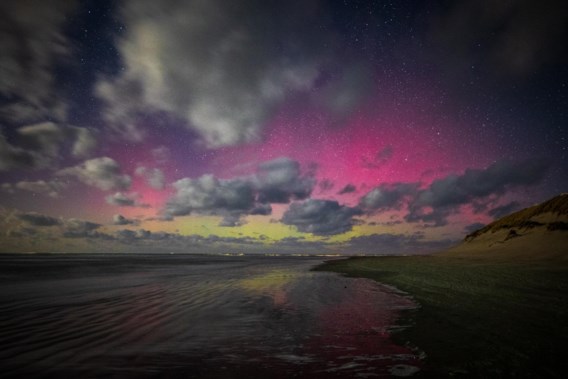To Iceland to see the Northern Lights? Save yourself the trouble, because with a little luck you can also enjoy this natural beauty in your own garden.
Today the internet was full of it: pictures of the northern lights that can be seen in Belgium and the Netherlands. Exceptional, right? We ask Katrin Kollenberg, professor of astrophysics at UAntwerp, VUB and KU Leuven.
What exactly are aurora borealis?
Kolenberg: It is a light phenomenon in which you see colored glow or moving bands in the sky. They also look like colored light curtains. Green and red, but sometimes blue and orange: it can have many colours. It mainly occurs around the poles. The northern lights in the Arctic, the aurora borealis, or the southern lights in the Antarctic, the aurora borealis.
It’s caused by electrons and ions, the charged particles that the sun is constantly spewing out into space. They fly millions of kilometers per hour towards the planets. The Earth’s magnetic field is slowing down, but it can still penetrate the upper layers of the atmosphere through the magnetic poles. There they interact with the elements in that atmosphere, which cause light.
Is it rare to see this also in us?
“Yes, it is rare. The sun must be very active, solar storms throw out so many charged particles that light is also visible at low latitudes. But the sun is not always active, because solar activity occurs in cycles of about eleven years. It was One of the last times we saw it properly here in Belgium was at the end of October 2003, when it was visible to the naked eye: the so-called “Halloween storms”
It has now been proven that a large solar eruption has occurred, so we know that a lot of particles will come towards Earth. You can then estimate when they will arrive.
Will we see this more often in the coming years?
“Yes, because we are now approaching the current solar cycle maximum. In addition, we will see more spots on the sun in the coming years, more explosions and storms, and therefore perhaps also more northern lights near us.
People usually think of the Sun as a good star, but in fact it is a very variable celestial body. A huge, hot ball of gas has its own life and its own phenomena that come back periodically. They must do so with the magnetic field of the sun itself.
The light turned red with us. Isn’t the typical color green?
The color depends on the molecules with which the ions interact. The gases in our atmosphere are composed of molecules and atoms, each with its own energy levels. Gases are “excited” by electrons and ions, and the way in which particles are “backtracked” varies from atom to atom. This is what determines the color. For example, particles colliding with oxygen can turn them green, and collisions with nitrogen can turn them red. It is about interactions in the high atmosphere. at an altitude of at least 100 km.
You say that the Earth’s magnetic field protects us. Does this mean that those particles would otherwise be harmful?
Yes, if this field did not exist, life on Earth would suffer from it. To what extent I can’t say – I’m not a doctor – but it would be harmful. This is also one of the reasons why astronauts are more vulnerable.
Is it dangerous to look at the northern lights, because then those particles get closer?
No, you are not taking any risks. The magnetic field protects us enough. However, severe solar storms can cause disruptions to our power grid. Sometimes it can lead to power outages.
The photos on social media looked rather amazing. Photoshop, or real?
‘I think they are real. Because the camera is more sensitive to light and color. Our eyes find it difficult to perceive this. With the naked eye you don’t see the same as what a camera can capture.
Should you go to a hill in the Ardennes to see it in the next few days?
No, because the pictures we have now seen came from Kempen and even from North Brabant. You should especially make sure that you are in a dark place with little light pollution. Make sure you are away from city lights as they give off an orange glow, which they obviously aren’t.
Once it’s dark, you look north, because that’s where particles enter our atmosphere. What can also help is setting a slow shutter speed on your camera. Yesterday it was only visible with a camera, but tonight it is probably with the naked eye.
What is the best time?
Sometimes people say it’s clearer later in the evening, but I’ll look when you can. It gets dark early, so you have this advantage.

“Total coffee specialist. Hardcore reader. Incurable music scholar. Web guru. Freelance troublemaker. Problem solver. Travel trailblazer.”







More Stories
GALA lacks a chapter on e-health
Weird beer can taste really good.
Planets contain much more water than previously thought